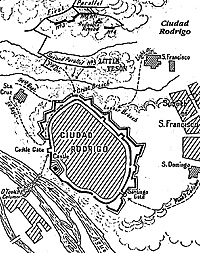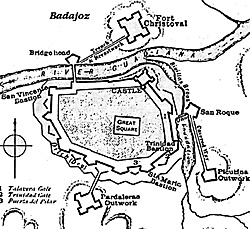Anyone who has followed Bernard Cornwell's series of novels about Richard Sharpe of 95th Rifles will remember the Cornwell's detailed descriptions of the "forlorn hope" tossed into the breach to cover the deployment and assault of the main body. In graphic detail Cornwell portrays the desperate men who plunged into the battered breach and risked certain death for the hope of promotion or gold. Few men survived, nor were they expected to. The rewards were great because the risk was even greater.
In the case of Ciudad Rodrigo, the French had feverishly worked to plug the great breach battered in the city walls by the British batteries on the Great Tenson. The French brought in more guns to cover the breech and to fire grapeshot into any formation that attempted to carry the breech. General Barrie' planned to make the British pay dearly for the city if it fell, but he preferred to hold out.
The Duke of Wellington did not have time to starve the city into submission and elected to storm it as soon as a breach could be made in its walls. The British had arrived on the 6th of January 1812 and after storming the San Fransico Convent and its supporting redoubt Wellington's men quickly began investing the city and digging the parallels. The British established a battery on the northern side of the city and pounded its walls day and night until, on the 18th, they had knocked two breaches in the face of the walls. Wellington offered terms to the garrison but Barrie refused.
Plans
Wellington planned to take the city by storming the two breaches with the 3rd and Light Divisions while three other columns attacked other locations. Pack's column (Portuguese) attacked the Santiago Gate, O'Toole's column (Portuguese) attacked the Castle Gate, and the 5th Regiment of Foot scaled the wall near the Castle Gate. The 94th Regiment of Foot supported the 3rd Division at the Great Breach. It was at the main attack at the Great Breach that the 3rd Division suffered the most. Total British losses were 561 while the French lost nearly 300 men killed and 1,500 captured.
The attack was successful by all terms. It had been well planned and executed and the French garrison was too small to cover the entire fortress and by attempting to hold every where Barrie' held nothing. Although it was the infantry that carried the day the role of the siege guns was the critical element.
Badajoz
Flushed with the success at Ciudad Rodrigo, Wellington attempted to repeat the victory at Badajoz. In this case the French were far more successful. The attack on the main Breach cost the British and their Portuguese allies 3,713 casualties. The 5,000 French in the city prepared it well for their English visitors and the assault of the Fourth and Light Divisions on the breach failed. The French inflicted nearly 3,000 casualties in an area the size of two football fields.
The attackers had to cross a number of obstacles as they approached the breach. The soldiers advanced into the darkness up a gentle slope designed to fatigue them and to give the defenders grazing fire. At the top edge of the slope was a ledge faced with stone that had to be jumped. Sappers and other units had tossed bales of straw down the wall ledges to break the fall of the their comrades. But since this operation was conducted in the dark most of the attackers found the ledge when they stepped off of it and fell into the darkness below. If they were lucky they landed on a bale of straw, if not they landed in rocks. The attacking troops behind they also fell over the ledge and if lucky they landed on straw or one of those who fell before them.
If they landed on a fellow soldier they most likely did him serious harm at the end of the eight-foot drop. Those brave soles who struggled to their feet then stumbled through a shallow pool of slimly water and up another slope. This slope too ended in a ledge. No sappers had prepared the bottom of this drop but it was only six feet to the stagnant pool below.
Again the attackers plunged over the ledge in the dark. All the while the French fired grape and small arms into the swarm of attackers. The base of the breach was a maze of scattered debris from the bombardment. The British soldiers struggled up the broken stone individually while the French who had made earthen works behind the breach fired volley after volley and tube after tube of grape shot into them. Most were wounded or killed before reaching half way and the French killed those who reached the top with bayonets when the attackers were stopped by the last obstacles.
The attack bogged down, its leaders killed or wounded and its force spent in the darkness. Still the attackers surged forward time after time only to be tossed back in confusion. The struggle became one of individual soldiers pressing forward and scaling the debris and bodies of their comrades. As the members of the Fourth and Light Divisions were weakened, the garrison commander reinforced the breach with more troops.
As the story at the breach goes on, two other attacks took place. Picton's 3rd Division attacked the Castle walls and stormed it by sheer will, with individuals scaling the thirty-foot walls by hand and then fighting the French at the top. As the attack gained ground, the French threw reserves into the fight at the Castle.
Elsewhere, the 5th Division and some Portuguese managed to enter the fortress by hard fighting after the French weakened the gate to send men to the breach and to the castle to fight Picton's division. These attacks eventually reached the breach from the rear and French resistance ended. The half-crazed attackers at the breach stormed into the city and rioted for four days, killing their own officers if they attempted to establish order.
In both cases, Ciudad Rodrigo and Badajoz, the scum that made up Wellington's army looted, raped, and murdered the citizens of the towns. There are very few excuses for such behavior. And the British, to their credit, never really have made excuses for their army's behavior.
You can read more about these assaults in Napier, the Cornwell novel, Sharpe's Company and in a new book by Donald Featherstone, Campaigning with the Duke of Wellington. Any one of these will inspire a go at the fortresses at the head of the Forlorn Hope.
The Problem of Terrain
Any one of these attacks can make a good skirmish game. The problem is making the terrain for the battle. I recommend stealing your kid's blocks and building a fortress wall and breach as a start. Or, if you have the time and money you can build a section of fortification and use it (see the sketches). My model is four foot by six foot. To build it, I mounted styrofoam on 1/8th inch paneling cut into 2' by 2' squares. Six of these were assembled to make the walls, moats, and obstacles for the game. The British have to attack down the length of the terrain. If you want to try the game without all the work, use bits of wood and books covered with a large felt cloth to make the model. Use a stack of books about eight to ten inches high for the main French wall and two lines of material four and two inches high for the ledge obstacles. You can simulate the breach by using stacks of blocks and wood in a hap-hazard way. The French built up the area behind the breach with earth works and you can use more books for these. The sloped areas leading to each obstacle can be made of foam board or paneling. Water obstacles should be easy for any wargamer to make. The sketch provides enough detail to build the terrain using either technique.
Game Rules This article appears in MagWeb (Magazine Web) on the Internet World Wide Web. Larger version of map at right: (Warning: big file--slow download)
Larger version of map at right: (Warning: big file--slow download)
 Larger version of map at right: (Warning: big file--slow download)
Larger version of map at right: (Warning: big file--slow download)
Random Event List (cards)
Back to Table of Contents -- Courier #71
© Copyright 1996 by The Courier Publishing Company.
Other military history articles and gaming articles are available at http://www.magweb.com